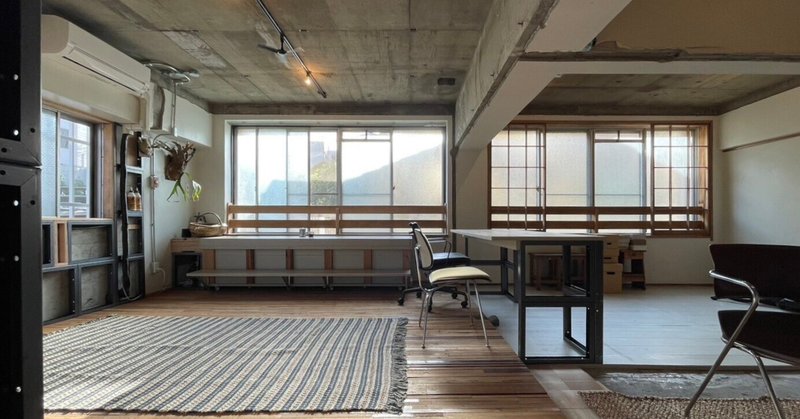
第7回 堀木インタビュー その2 7th Interview with Horiki Part 2
〈タケノマル〉という場所を作りながら、堀木の考え方も少しずつ変わっていきました。手を動かすことで考えを深めていくということは、とても職人的な行為にも思えます。紙箱作りのプロフェッショナルが、何を大切にして、どんなことに影響を受け、どんなふうに変化して、どんなところに悩んでは解決をしてリノベーションを行ってきたのか。そこには内装のプロフェッショナルではありえない、かもしれないおもしろさがあると思うのです。
Horiki's way of thinking changed little by little as he created this place called "Takenomaru. Deepening one's thinking by working with one's hands seems to me to be a very artisanal act. What did a professional paper box maker value, what were his influences, how did he change, and what did he have to worry about and solve in order to renovate? I think there is something interesting in that, which may or may not be possible for interior design professionals.
もうひとつ意識しているのは「やりすぎない」ということです。もともとゼロか100か、やるかやらないかという性格なのだと思うのですけれど、それが年齢とともにどちらでもない、グレーゾーンのようなところができてきて、そのグレーゾーンの適当さ加減を「いいな」と思うようにもなってきました。もし今よりももう少し若かったら徹底的に、費用もかけられるだけかけていた可能性もあります。そういう意味では時期がちょうどよかったのかもしれません。
Another thing I am conscious of is "not overdoing it. I think I have always been a zero or one hundred kind of person, a do-it-or-don't-it kind of person, but as I have gotten older, I have developed a kind of gray zone where I am neither, and I have come to think that I like the appropriateness of that gray zone. If I had been a little younger, I might have been more thorough and spent as much as I could. In that sense, the time may have been just right.
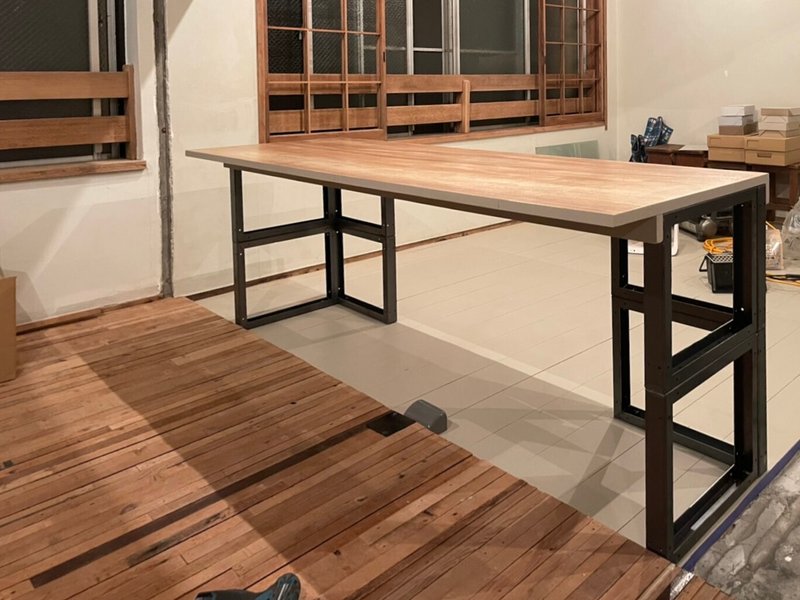
なぜ廃墟とか廃墟的なものに惹かれるのかということを言語化すると、人間の儚さのようなものを感じるからなのだと思います。ある種の人間らしさというか、素の状態というか素材感をむき出しにされているというか、化粧をしていないイメージでしょうか。家にしても何にしても、ある空間を作るということは壁や天井に化粧をしていくことでもあると思います。それを全て剥いだ状態、もともと隠れていたものが現れてくることに魅力を感じるのです。
If I were to verbalize why I am attracted to ruins and derelict things, I think it is because I sense a kind of human fragility. I guess you could say it is a certain kind of humanity, or the bare state of a person, or the bare materiality of a person, or the image of a person without make-up. Whether it is a house or anything else, creating a certain space means putting makeup on the walls and ceilings. I find it fascinating that when all of this is stripped away, what was originally hidden is revealed.
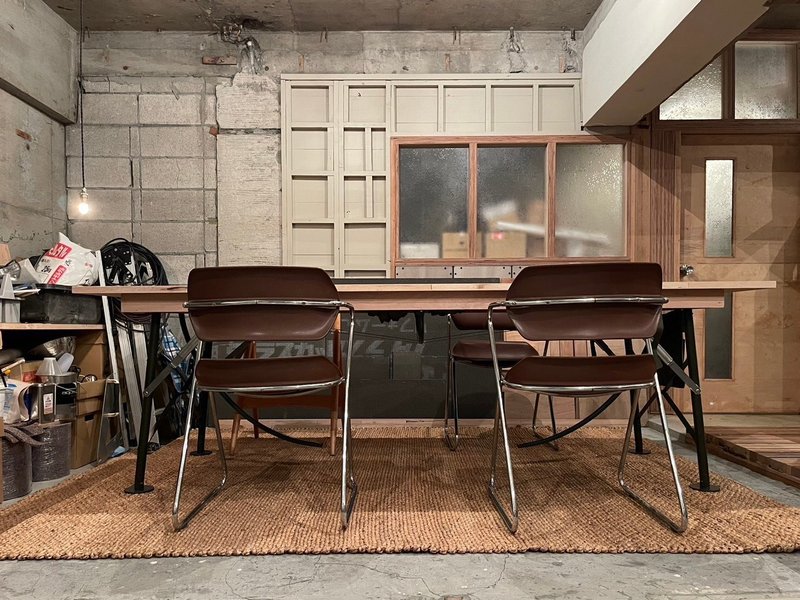
例えばとてもいい雰囲気のお店に行ったときには、必ずトイレを見てしまいます。トイレがイカしているとそれだけでも「ああ、いい空間だなあ!」となるのですが、どれだけ見えるところが素敵だったとしても、それがトイレまで行き届いていないと残念に思ってしまいます。そのあたりが流石だなと感心させられてしまうのがレアジェムの西條賢さん(第2回参照)です。彼が手がけた小伝馬町〈ピッツェリア・イル・タンブレッロ〉もトイレがすごくかっこいい。
For example, when I go to a restaurant with a very nice atmosphere, I always look at the restroom. If the restrooms are nice, that alone is enough to make me think, "Oh, what a nice space!" But no matter how nice the visible area is, I feel disappointed if it does not extend to the restrooms. I was impressed by Ken Nishijo of Raregem (see Part 2), who is a master in this area. His work on Kodenmacho's Pizzeria Il Tamburello also has very cool restroom.
その見せ方というか、力の入れ方や抜き方、さじ加減というようなもの、作り込みすぎていてもよくありません。一見、適当そうにも思える中で、きっちりと要所は押さえている。そういうものがいいし、そういう姿勢がいい。テーブルでも何でも、家具も必ず裏を見てしまいます。だから紙箱も同じですけれど、重要なのは内側です。乱暴な言い方になるかもしれませんが、表はよくてあたり前。裏にどんな紙を貼り、どんな仕上げをするのかということに気を配るべきなのだと思います。
It is not good to overdo it in terms of the way the work is presented, or in terms of how much effort is put in or taken out, or in terms of the degree to which the work is moderated. While at first glance, it may seem appropriate, the key points are held firmly in place. That is what is good, and that is what I like about this attitude. We always look at the back of a piece of furniture, whether it is a table or anything else. So it is the same with paper boxes, but what is important is the inside. This may sound rough, but the front side is just as good as the back. We should pay attention to what kind of paper is pasted on the back and how it is finished.
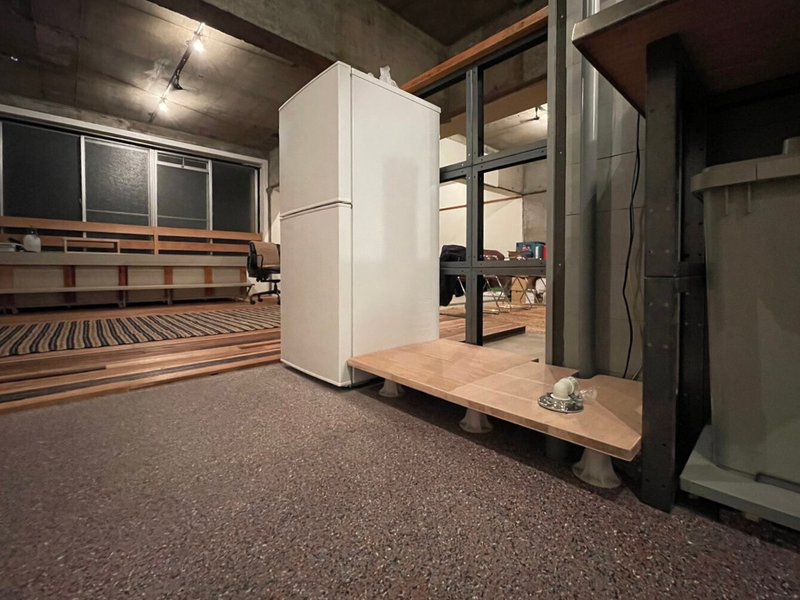
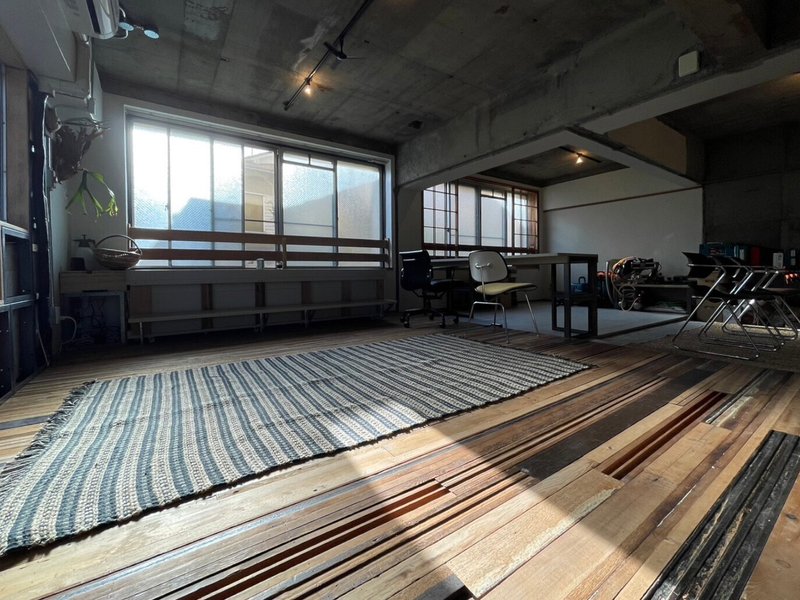
化粧ということで言えば、その最たるもののひとつはペンキ。だからタケノマルも最初はペンキをどんどん剥いでいきました。素材感をむき出しにするということが始めのうちのコンセプトでしたが、それを揺るがす出来事がありました。スギ板の無垢の壁材をたくさんいただいたのです。これをどう生かそうかということが変化のきっかけにはなりましたが、よい結果になったのではないかと思います。また、〈ATELIER MUJI GINZA〉で観たワイズベッカーの展示にも影響を受けました。
In terms of cosmetics, there is paint, for example. That is why at first we stripped the paint off of Takenomaru as we went along. The initial concept was to expose the materiality of the material, but then something happened that shook that concept. We received a lot of solid cedar planks for the walls. The question of how to make the most of this material became the catalyst for change, but I think it turned out to be a good result. I was also influenced by the Wiesbecker exhibit I saw at "ATELIER MUJI GINZA.

最初のコンセプトは素材感を生かすということ。コンクリートはコンクリートのまま、木は木のままというふうに。だからペンキを塗るということは真逆のことでした。しかし、ワイズベッカーの展示を観てしまうと色を塗りたくなる衝動にも駆られたというのも事実です。素材をむき出しにしてその表情を愛でるということを”タケノマル1.0”だとすると、新たな素材を得てワイズベッカーの影響を受けてからのことは”タケノマル2.0”ということになります。
The first concept was to make the most of the materials. Concrete should be left as concrete, and wood should be left as wood. Therefore, painting was the exact opposite. However, it is also true that after seeing the Wiesbecker exhibition, I felt the urge to paint. If we call the process of laying the material bare and admiring its expression "Takenomaru 1.0," then the process of acquiring new materials and being influenced by Wiesbecker's work is called "Takenomaru 2.0.
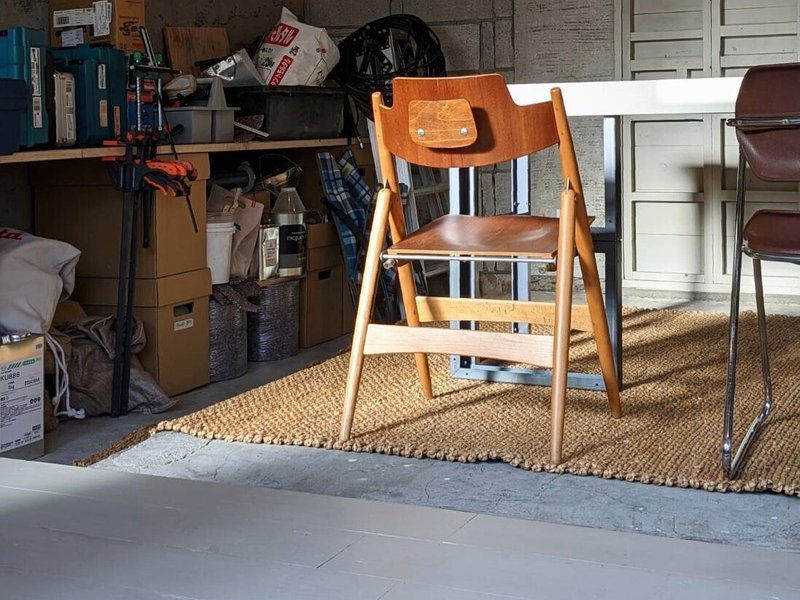
ワイズベッカーに共感したのは、図面を引いて切ってもらったものを組み立てているだけだというところ。こちらも不器用で切ってもらったりしていたので。彼の場合は全く違う理由だとは思うのですが、勝手に共感してしまいました。それから表情を殺すというか、塗ることで素材感をあえてなくしてしまうところ。1.0のコンセプトからするとペンキを塗るなんて考えられないのですが、1.0と2.0のバランス、そのバランスを取ることが「やりすぎない」ということなのだと気がつきました。
What I sympathized with Wiesbecker was that he was just assembling what he had drawn and cut. I was also clumsy and had to have it cut. I think in his case it was for a completely different reason, but I sympathized with him. I also noticed that he dared to kill the expression, or rather, to lose the sense of material by painting, which is unthinkable from the concept of 1.0, but I realized that the balance between 1.0 and 2.0, and the balance to be struck between them, is "not overdoing it".

デスクのトップをニスで仕上げたのはラワンの表情を見せたいと思ったからです。何も考えずにそうしていたのですが、よくよく考えてみると塗ったけれど表情も出せているので、1.0でも2.0でもありません。新しい発見でした。これはキッチンのラワン材の窓枠にファイヤープロテクト(防炎のための木部塗料)を塗ったときのことにも繋がります。コンロが近いので防火のためだったのですが、思ったよりも色が濃く、そこだけ表情が変わってしまったのです。
I varnished the top of the desk because I wanted to show the expression of the lauan. I did so without thinking about it, but when I thought about it, I realized that although I painted it, I also gave it an expression, so it is neither 1.0 nor 2.0. It was a new discovery. This leads me to the time I painted the lauan window sills in the kitchen with Fire Protect (wood paint for fire prevention). It was for fire protection because of the proximity of the stove, but the color was darker than I expected and that was the only place where the look changed.
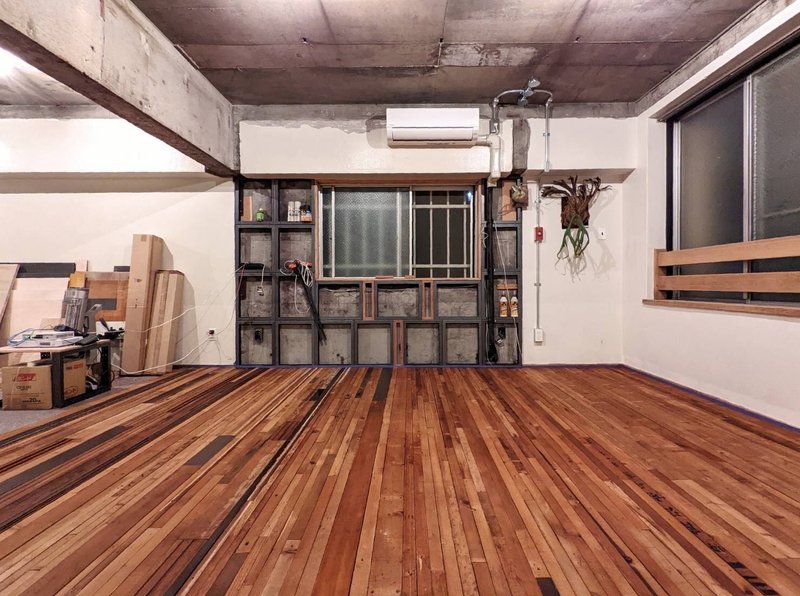
塗ったところと塗っていないところ、その整合性をどう取るのかで悩んだ結果、ファイヤープロテクトはキッチンのラワン材と廃材を敷き詰めた床にだけ塗ることにしました。1.0と2.0のどちらに振るのかという悩みでもあったのですが、おそらくどちらに振ったとしても「やりすぎない」ということからは離れてしまっていたと思います。これを3.0というのか2.1というのかはわかりませんが、やらなければならないことはやる、それが答えでした。
I was struggling with how to achieve consistency between painted and unpainted areas, so I decided to apply Fire Protect only to the kitchen's lauan wood and scrap wood flooring. I think that I would have been far from "not overdoing it. I don't know whether to call it 3.0 or 2.1, but the answer was to do what had to be done.
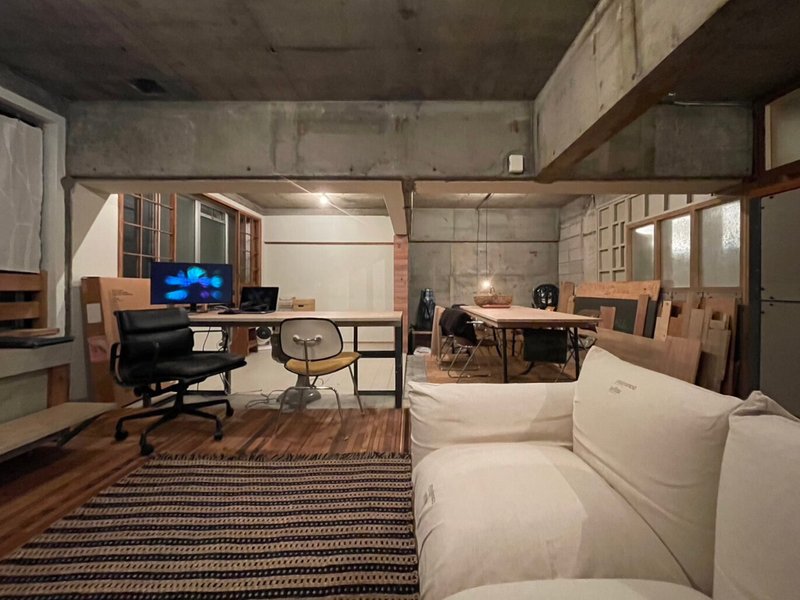
この記事が気に入ったらサポートをしてみませんか?
